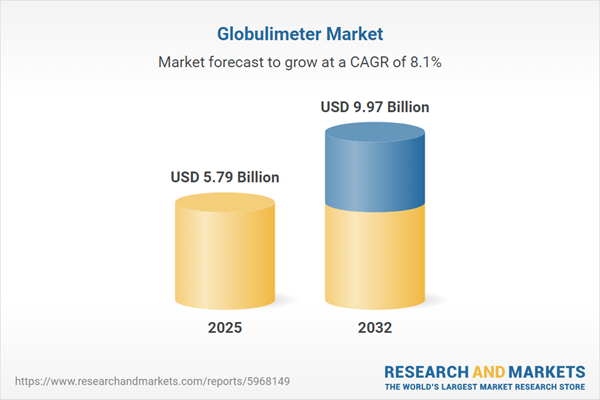Speak directly to the analyst to clarify any post sales queries you may have.
The globulimeter market is entering a phase of transformational growth, shaped by ongoing technological innovations, evolving clinical needs, and heightened regulatory scrutiny. Senior stakeholders must navigate complex dynamics to capitalize on new opportunities and future-proof operations in this critical segment of hematology diagnostics.
Market Snapshot: Hematology Analyzer Market Size and Trajectory
The globulimeter market grew from USD 5.36 billion in 2024 to USD 5.79 billion in 2025. It is expected to continue expanding at a compound annual growth rate (CAGR) of 8.06%, reaching USD 9.97 billion by 2032. This outlook reflects sustained demand for innovative hematology analyzers in both emerging and mature healthcare systems.
Scope & Segmentation
- Technology Platforms: Automated, manual, and semi-automated globulimeter solutions address varying workflow and budgetary requirements in modern laboratories.
- End User Environments: Clinical laboratories, hospital laboratories, point-of-care settings, and research laboratories each present distinct operational and performance needs.
- Applications: Diagnostic centers, home care, hospitals and clinics, and research institutes adopt analyzer types suited to their volume and user expertise.
- Product Types: Benchtop analyzers offer comprehensive results in centralized labs, while portable units enable field or bedside diagnostics.
- Distribution Channels: Direct sales (corporate sales team, field sales), distributors (international and local), and online sales (company website, e-commerce platforms) facilitate outreach and service delivery.
- Calibration Types: Linear and non-linear methodologies enable precise measurement, accommodating a range of clinical testing scenarios.
- Covered Regions: Americas (including North America and Latin America), Europe, Middle East & Africa, and Asia-Pacific markets reflect diverse regulatory, economic, and adoption factors.
- Key Companies Profiled: Sysmex Corporation, Abbott Laboratories, Beckman Coulter, Siemens Healthineers, Becton, Dickinson and Company, Mindray Medical, HORIBA, Nihon Kohden, Bio-Rad Laboratories, Transasia Bio-Medicals.
Key Takeaways for Senior Decision-Makers
- Advancements in microfluidics and artificial intelligence are modernizing globulimeter capabilities, supporting rapid, multi-parameter blood analysis in diverse settings.
- Automated analyzers facilitate high-throughput operations, while manual and semi-automated options provide flexible, cost-efficient solutions for smaller or specialized environments.
- Integration of laboratory systems with electronic health records and remote monitoring tools is accelerating seamless clinical workflows and supporting telemedicine.
- Regulatory frameworks in the US and Europe continue to evolve, demanding enhanced quality assurance and product validation, which impact product development and market entry strategies.
- Emerging economies in Asia-Pacific and Latin America are driving demand for adaptable platforms suited to varying infrastructure and budget levels.
Impact of 2025 US Tariffs on the Hematology Analyzer Supply Chain
Recent tariffs imposed in the United States have introduced cost pressures and supply chain complexity for hematology analysis equipment and consumables. Manufacturers are diversifying suppliers, exploring local production, and forming strategic alliances to maintain resilience and cost control. Laboratory procurement teams may encounter shifting pricing and longer lead times in the short term, but industry-wide adaptations are strengthening supply networks and promoting long-term agility.
Primary Keyword Focus: Globulimeter Market Technology Trends
The globulimeter market is witnessing a significant transition, with technology platforms ranging from manual to automated analyzers. Deployment of AI and cloud-based analytics is enhancing clinical accuracy and enabling scalable, modular solutions. These trends are influencing purchasing strategies among high-throughput diagnostic centers and decentralized, point-of-care environments alike.
Methodology & Data Sources
This report is built on a mixed-methods approach, combining primary interviews with laboratory leaders and procurement managers with extensive review of scientific literature, regulatory documents, and industry publications. Rigorous data triangulation and peer review ensure accuracy and context for every insight.
Why This Report Matters
- Enables strategy formulation with detailed segmentation and clear technology roadmaps across the globulimeter market.
- Empowers procurement, investment, and business development leaders to anticipate regulatory, supply chain, and digitalization trends.
- Delivers actionable intelligence on evolving market drivers, regional dynamics, and innovation pathways, supporting informed decision-making.
Conclusion
The globulimeter market is advancing toward greater connectivity, automation, and adaptability. Decision-makers equipped with these insights will strengthen their competitive position and drive value in a complex, global diagnostic landscape.
Additional Product Information:
- Purchase of this report includes 1 year online access with quarterly updates.
- This report can be updated on request. Please contact our Customer Experience team using the Ask a Question widget on our website.
Table of Contents
3. Executive Summary
4. Market Overview
7. Cumulative Impact of Artificial Intelligence 2025
Companies Mentioned
The companies profiled in this Globulimeter market report include:- Sysmex Corporation
- Abbott Laboratories
- Beckman Coulter, Inc.
- Siemens Healthineers AG
- Becton, Dickinson and Company
- Mindray Medical International Limited
- HORIBA, Ltd.
- Nihon Kohden Corporation
- Bio-Rad Laboratories, Inc.
- Transasia Bio-Medicals Ltd.
Table Information
| Report Attribute | Details |
|---|---|
| No. of Pages | 182 |
| Published | October 2025 |
| Forecast Period | 2025 - 2032 |
| Estimated Market Value ( USD | $ 5.79 Billion |
| Forecasted Market Value ( USD | $ 9.97 Billion |
| Compound Annual Growth Rate | 8.0% |
| Regions Covered | Global |
| No. of Companies Mentioned | 11 |









